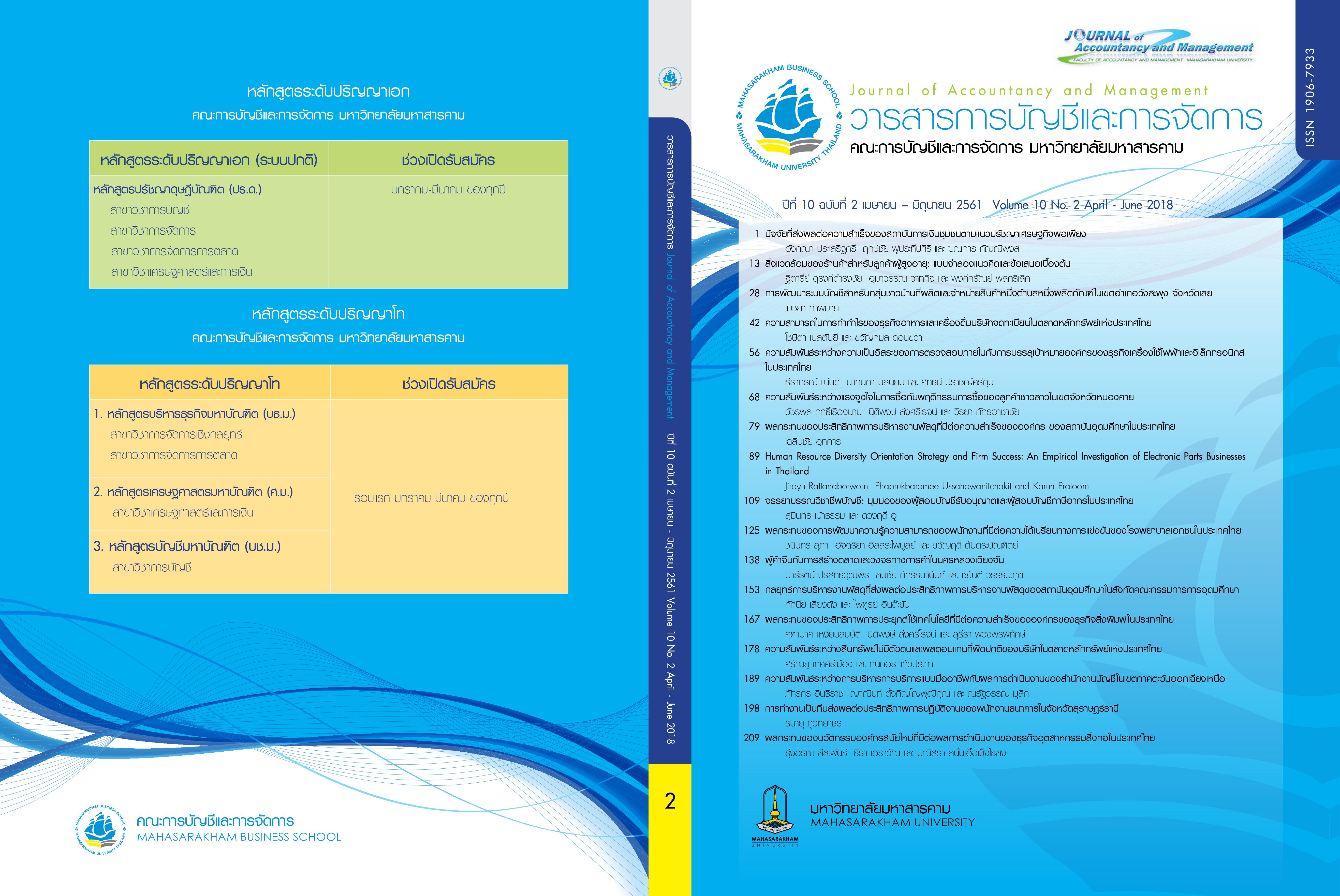ความสัมพันธ์ระหว่างสินทรัพย์ไม่มีตัวตนและผลตอบแทนที่ผิดปกติของบริษัท ในตลาดหลักทรัพย์แห่งประเทศไทย
Main Article Content
บทคัดย่อ
การศึกษาครั้งนี้มีวัตถุประสงค์เพื่อศึกษาความสัมพันธ์ของสินทรัพย์ไม่มีตัวตนกับผลตอบแทนที่ผิดปกติ โดยใช้ข้อมูลจากตลาดหลักทรัพย์แห่งประเทศไทย ปี 2556 – 2558 ในการเก็บรวบรวมข้อมูล จำนวน 460 บริษัท และสถิติที่ใช้ในการวิเคราะห์ข้อมูลได้แก่ ค่าเฉลี่ย ส่วนเบี่ยงเบนมาตรฐาน วิเคราะห์สหสัมพันธ์ การวิเคราะห์ถดถอยพหุคูณ ผลการศึกษา พบว่า สินทรัพย์ไม่มีตัวตนที่สามารถระบุได้ มีความสัมพันธ์กับผลตอบแทนที่ผิดปกติเนื่องจากสินทรัพย์ไม่มีตัวตนนั้นสามารถใช้พยากรณ์กำไรในอนาคตได้ และสินทรัพย์ไม่มีตัวตนที่ไม่สามารถระบุได้ (ค่าความนิยม) ไม่มีความสัมพันธ์กับผลตอบแทนที่ผิดปกติ เนื่องจากค่าความนิยมในมุมมองนักลงทุนไม่ได้ก่อให้เกิดกระแสเงินสดเหมือนสินทรัพย์อื่นๆ ดั้งนั้นนักลงทุนควรให้ความสำคัญกับสินทรัพย์ไม่มีตัวตนที่สามารถเพิ่มผลตอบแทนจากการลงทุนได้
Downloads
Article Details
บทความที่ได้รับการตีพิมพ์เป็นลิขสิทธิ์ของวารสารการบัญชีและการจัดการ
ข้อความที่ปรากฏในบทความแต่ละเรื่องในวารสารวิชาการเล่มนี้เป็นความคิดเห็นส่วนตัวของผู้เขียนแต่ละท่านไม่เกี่ยวข้องกับมหาวิทยาลัยมหาสารคาม และคณาจารย์ท่านอื่นๆในมหาวิทยาลัยฯ แต่อย่างใด ความรับผิดชอบองค์ประกอบทั้งหมดของบทความแต่ละเรื่องเป็นของผู้เขียนแต่ละท่าน หากมีความผิดพลาดใดๆ ผู้เขียนแต่ละท่านจะรับผิดชอบบทความของตนเองแต่ผู้เดียว
เอกสารอ้างอิง
ลัคนา พูลเจริญ. (2555). ความสัมพันธ์ระหว่างค่าความนิยมที่เกิดจากการซื้อธุรกิจกับความสามารถในการทำกำไรของบริษัทจดทะเบียนในตลาดหลักทรัพย์แห่งประเทศไทย. วิทยานิพนธ์บริหารธุรกิจมหาบัณฑิต สาขาการบัญชี. มหาวิทยาลัยเทคโนโลยีราชมงคลธัญบุรี.
ศิรดา นวลประดิษฐ์. (2547). ความสัมพันธ์ระหว่างค่าความนิยมที่เกิดจากการรวมธุรกิจและความสามารถในการทำกำไรของบริษัทจดทะเบียนในตลาดหลักทรัพย์แห่งประเทศไทย. วิทยานิพนธ์บัญชีมหาบัณฑิต สาขาการบัญชี. มหาวิทยาลัยจุฬาลงกรณ์.
ศันสนีย์ สุริยเชิดชูสกุล. (2548). ความสัมพันธ์ระหว่างค่าความนิยมกับผลการดำเนิน งานและกระแสเงินสดของกิจการในอนาคตของบริษัทจดทะเบียนในตลาดหลักทรัพย์แห่งประเทศไทย. วิทยานิพนธ์บัญชีมหาบัณฑิต สาขาการบัญชี. มหาวิทยาลัยจุฬาลงกรณ์.
สภาวิชาชีพบัญชี ในพระบรมราชูปถัมภ์. (2558). มาตรฐานรายงานทางการเงิน ฉบับที่ 3 (ปรับปรุง 2557) การรวมธุรกิจ.
Neeraj J, G.(2007).Do stock prices reflect the value of intangible investments in customer assets. Doctoral Dissertations. Paper AAI3289510.
Ely, K., & Waymire, G. B.(1999).Intangible assets and equity valuation in the pre-SEC era. University of Chicago.
Ritter, A., & Wells, P. (2006). Identifiable intangible asset disclosures, stock prices and future earnings.Accounting & Finance, 46, 843-63.
Yoon, S. S., & Miller, G. (2003). The functional relationships among earnings, cash flows and stock returns in korea. Review of Accounting and Finance. 2(1), 40-58.
Ball, R., & Brown, P. (1968). An empirical evaluation of accounting income numbers. Journal of Accounting Research, 6(2), 159–178.
Stevens, M. W. (1992). Cytopathology of malignant mesothelioma: a stepwise logistic regression analysis. Diagnostic Cytopathology. 8(4), 333-341.
Black, K. (2006). Businesses statistics : For contemporary decision making (4th ed.). USA :John Wiley & Sons.
Brown, S. J., & Warner, J. B. (1980). Measuring security price performance. Journal of financial economics, 8(3), 205-258.


